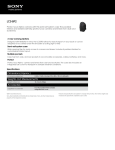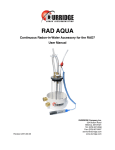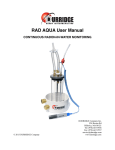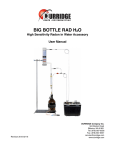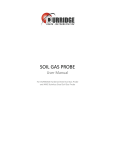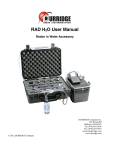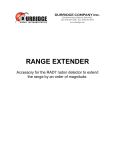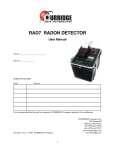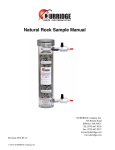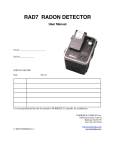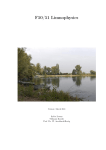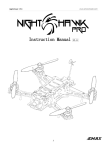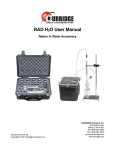Download Duty Cycle Controller User`s Manual
Transcript
DUTY CYCLE CONTROLLER CONTENTS 1. Introduction!.......................................................................................3 2. Operating Instructions !.....................................................................3 3. Electrical and Mechanical Specifications!.......................................4 3.1 Electrical Specifications!..............................................................................4 3.2 Mechanical Specifications!...........................................................................4 4. Use with the DRYSTIK and the RAD7!..............................................5 4.1 Soil gas monitoring!......................................................................................5 4.2 Minimum flow rate!........................................................................................6 4.3 Correcting for very low flow rates!...............................................................7 4.4 Thoron!............................................................................................................7 1. Introduction The DURRIDGE Duty Cycle Controller controls the on and off time of a DC voltage powered device, resulting in lower power usage, lower consumption of consumable resources, and, in the case of a device with a pump, lower average flow rate. The DURRIDGE Duty Cycle Controller accepts a continually-on supply voltage between 9-15 VDC and converts it to a modulated square wave signal. The duty cycle of a signal is defined as a ratio of the time the signal is on to the total period of the cycle (the on and off time combined). If a signal is continuously on, it has a duty cycle of 100% Duty Cycle = (On Time)/(Total Cycle Time) The DURRIDGE Duty Cycle Controller can be used in any application where the duty cycle of a DC power supply needs to be controlled. The signal is always turned on for approximately 3 seconds and then turned off for any amount of time between 0 and 1000 seconds (except when the output is turned fully off). The output signal can be used to power any DC powered device which runs on voltages between 9 and 15 VDC. As the output signal of the Duty Cycle Controller is turned on and off, so is the DC powered device. 2. Operating Instructions To use the Duty Cycle Controller, plug a DC power supply or battery (9-15V) into the “Voltage In” connector on the side of the Duty Cycle Controller. Use the provided cable to connect the “Voltage Out” of the Duty Cycle Controller to the voltage input on the device to be controlled. For example, to use the Duty Cycle Controller to power the DURRIDGE Active DRYSTIK, the system would be set up as shown in paragraph 4, page 5. The Duty Cycle Controller provides a voltage output almost equal in magnitude to the input voltage with a selectable duty cycle. The duty cycle of the output voltage is selected by the position of the knob on the Duty Cycle Controller. ©2010, DURRIDGE Company, Inc. When the knob is turned all of the way to the right the output will be continually on. When the knob is turned all the way left the output will be continually off. In between these two positions, the duty cycle can be varied between 100% and 0.3%. The LED on the front of the Duty Cycle Controller lights up when the output signal is on. The behavior of the Duty Cycle Controller for a setting of 33% duty cycle is shown in section 3.1, page 4. Note that the timing will vary slightly with changes in temperature. Because of this, the times and duty cycles on the face plate of the Duty Cycle Controller are approximate. The user should always note the performance of the device being controlled and adjust the Duty Cycle Controller as necessary. DCC Page 3 3. Electrical and Mechanical Specifications 3.1 Electrical Specifications 3.2 Mechanical Specifications Voltage Input (VDC) 9 - 15V Length (mm/inches) 101 / 3.9 Maximum Output Current (A) 1A Height (mm/inches) 41 / 1.6 Minimum Operating Temperature (°C) 0 °C Width (mm/inches) 50 / 2.0 Maximum Operating Temperature (°C) 50 °C Weight (g/oz) 30 / 4.6 Input Connector is a 2.1mm DC Power Jack Output Connector is a 3.5mm Tip-Sleeve Jack ©2010, DURRIDGE Company, Inc. DCC Page 4 4. Use with the DRYSTIK and the RAD7 4.1 Soil gas monitoring The duty cycle controller was produced specifically for long-term monitoring of soil gas radon concentration with a soil gas probe. It controls the operation of an active DRYSTIK in the sample path upstream of a RAD7 Radon Detector, enabling the average flow rate to be reduced to such a level that there is no effect of fresh air diffusing down through the soil to the sampling point. With this setup, continuous monitoring of soil gas from one sample point may be performed indefinitely. The maximum permissible flow rate depends on the porosity of the soil and the depth of the probe. point. We may then accept that the air at the sampling point continues to stay very close to equilibrium with the radium in the soil. The half life of radon is 3.8 days. The air sample may be considered to be drawn from a sphere centered on the sampling point. If that sphere takes two weeks to grow before it just touches the ground surface, then it takes two weeks for air to filter down to the sampling Maximum flow rate, F, is roughly given by: ©2010, DURRIDGE Company, Inc. For a probe depth of D cm, the maximum sphere volume will be 4πD3/3,000 litres. If the porosity of the soil is 50%, the corresponding air volume will be 2πD3/3,000. Two weeks is about 20,000 minutes. So the average flow rate must be less than 2πD3/60,000,000 litre/min. If we allow that 2π is close to 6, the rate must be less than D3 * 10-7 litre/min where D is the probe depth in cm. F = D3 / 107 litre/min where D is the probe depth in cm DCC Page 5 Sphere of soil gas drawn into sampling point. If, for example, D is about two feet, or 61cm, the maximum flow rate to meet this criterion for continuous sampling will be 0.022 L/min. Uncertainties in the porosity and other assumptions may make it advisable, for this depth, to keep the flow rate less than 0.01 L/ min. the surface. Increasing the depth by 26%, to 77cm, will allow double the flow rate, assuming uniform soil porosity down to 2m or so. Typically, the ON flow rate of an active DRYSTIK is set to about 0.2 L/min to match the average flow rate of a RAD7 where the pump, pumping at 1 L/min, runs for one minute in every five. So the duty cycle controller, which is placed between the 12V supply and the DRYSTIK power input, should be set to a duty cycle of about 5%, or an off time of about one minute, to produce an average flow rate of 0.01 L/min from the soil gas probe. Radon has a half life of 3.8 days. If the air sample takes more than an hour or two to reach the measurement chamber, there may be sufficient loss of sample that a correction for sample decay is called for. With a laboratory drying unit in the air path, you can assume a sample path volume of about 2 litres plus more if the probe is so far from the RAD7 that the volume of the tubing becomes significant. If the probe is close to the RAD7, within 10m, say, and 2 hours is the maximum acceptable delay before corrections have to be applied, the minimum permissible flow rate will be 2L / 120min = 0.016 L/min. At flows below this rate, a correction factor for radon decay in the sample may be required. With a probe depth of 61cm and a porosity of 50%, this setting will enable continuous, indefinite sampling of the soil gas for radon concentration without significant dilution of the sample by fresh air diffusing down from ©2010, DURRIDGE Company, Inc. 4.2 Minimum flow rate DCC Page 6 4.3 Correcting for very low flow rates In the examples above, it may be seen that for a probe depth of 61cm, to avoid dilution of the air sample after a week or two of sampling, a flow rate of no more than 0.01L/ min is desired, but with this flow rate the sample will lose some radon by radioactive decay during sample acquisition. One solution to this problem would be to increase the sampling depth to 2ft 6inches (77cm) or more and draw at an average flow rate of 0.02 L/min. This may be obtained with a duty cycle of 10% (or OFF times of 27 sec.) on the Duty Cycle Controller and a DRYSTIK ON flow rate of 0.2 L/min. Another solution would be to leave the sampling point at 2ft (61cm), draw at an average flow rate of 0.02 L/min, take note of any long-term change in the average after one week of sampling, and apply a correction for fresh air infiltration to readings after three or four weeks of sampling. A third solution would be to keep the probe at 2ft (61cm) and keep the flow rate at 0.01 L/ min. Assuming a sample volume of 2L, this will cause an acquisition time of around 2 / ©2010, DURRIDGE Company, Inc. 0.01 min = 200 minutes. In 200 minutes, about 2.5% of the radon will have been lost by radioactive decay. A factor of 1.025 may therefore be applied to the reading to correct for the loss. 4.4 Thoron Thoron has a half life of less than a minute. An active DRYSTIK with Duty Cycle Controller will, inevitably, cause sample acquisition delays far in excess of one minute. Therefore they may not be used for the measurement of thoron. To measure thoron in soil gas, the DRYSTIK may still be used, but the needle valve should be bypassed and the pump run continuously. The flow rate will then be close to 1 L/min if the soil is porous. At a flow rate of 1 L/min, with a Laboratory Drying Unit in the sample path, the sample delay increase over standard thoron protocol will be about 1 minute, so that the thoron readings should be multiplied by a factor of 2. If the flow rate is reduced and/or if the sample volume is bigger, there will be a bigger correction factor. DCC Page 7







